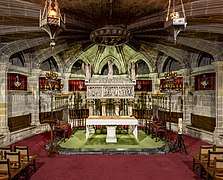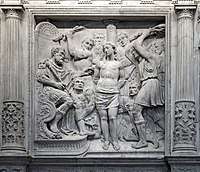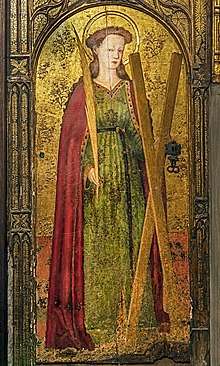Eulalia of Barcelona
| Saint Eulalia of Barcelona | |
|---|---|
 Tomb of Saint Eulalia in the crypt of Barcelona Cathedral | |
| Born |
c. 290 Barcelona, Hispania (Spain) |
| Died |
c. 303 (aged 12–13) Barcelona, Hispania |
| Venerated in | Roman Catholicism and Eastern Orthodoxy |
| Canonized | 633 |
| Major shrine | Cathedral of Santa Eulalia, Barcelona |
| Feast | February 12 (August 22 in the Orthodox Church) |
| Attributes | X-shaped cross, stake, and dove |
| Patronage | Barcelona, Spain; sailors; against drought |
Saint Eulalia (Aulaire, Aulazia, Olalla, Eulària) (c. 290–12 February 303), co-patron saint of Barcelona, was a 13-year-old Roman Christian virgin who suffered martyrdom in Barcelona during the persecution of Christians in the reign of emperor Diocletian (although the Sequence of Saint Eulalia mentions the "pagan king" Maximian). There is some dispute as to whether she is the same person as Saint Eulalia of Mérida, whose story is similar.[1]

For refusing to recant her Christianity, the Romans subjected her to thirteen tortures; including:
- Putting her into a barrel with knives (or glass) stuck into it and rolling it down a street (according to tradition, the one now called Baixada de Santa Eulalia "Saint Eulalia's descent").[2]
- Cutting off her breasts
- Crucifixion on an X-shaped cross. She is depicted with this cross, the instrument of her martyrdom.
- Finally, decapitation.


A dove is supposed to have flown forth from her neck following her decapitation. This is one point of similarity with the story of Eulalia of Mérida, in which a dove flew from the girl's mouth at the moment of her death. In addition, Eulalia of Mérida's tortures are sometimes enumerated among the Barcelona martyrs, and the two were similar in age and year of death.
Eulalia is commemorated with statues and street names throughout Barcelona.[2] Her body was originally interred in the church of Santa Maria de les Arenes (St. Mary of the Sands; now Santa Maria del Mar, St. Mary of the Sea). It was hidden in 713 during the Moorish invasion, and only recovered in 878. In 1339, it was relocated to an alabaster sarcophagus in the crypt of the newly built Cathedral of Santa Eulalia.[3] The festival of Saint Eulalia is held in Barcelona for a week around her feast day on February 12.[4]
See also
- Sequence of Saint Eulalia – French hagiography from AD 880
References
- ↑ Haliczer, Stephen (2002). Between exaltation and infamy: Female mystics in the Golden Age of Spain. Oxford: Oxford University Press. p. 236. ISBN 0-19-514863-0.
- 1 2 Vázquez Montalbán, Manuel (1992). Barcelonas. London: Verso. p. 42. ISBN 0-86091-353-8.
- ↑ Santa Maria del Mar Archived 2006-02-05 at the Wayback Machine. from New York Times travel guide.
- ↑ Festes de Santa Eulàlia from Barcelona municipal website (in Catalan)
| Wikimedia Commons has media related to Saint Eulalia of Barcelona. |
External links
- St. Eulalia of Barcelona from the Catholic Encyclopedia
- EULALIA of Barcelona from catholic-forum.com
- Saint of the Day, February 12: Eulalia of Barcelona at SaintPatrickDC.org
- Eulalia of Barcelona at Find a Grave
- St. Eulalia page at the Christian Iconography web site
- Hymn to St. Eulalia in Prudentius, Peristephanon, Carmen III
- Translation of the Prudentius hymn, by Robert J. Baker
- La Cantilène de Sainte Eulalie
- Translation of the Cantilène by Richard Stracke